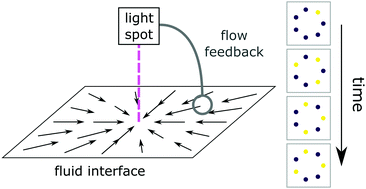当前位置:
X-MOL 学术
›
Soft Matter
›
论文详情
Our official English website, www.x-mol.net, welcomes your feedback! (Note: you will need to create a separate account there.)
Feedback control of photoresponsive fluid interfaces†
Soft Matter ( IF 3.4 ) Pub Date : 2018-02-19 00:00:00 , DOI: 10.1039/c7sm02101a Josua Grawitter 1, 2, 3, 4, 5 , Holger Stark 1, 2, 3, 4
Soft Matter ( IF 3.4 ) Pub Date : 2018-02-19 00:00:00 , DOI: 10.1039/c7sm02101a Josua Grawitter 1, 2, 3, 4, 5 , Holger Stark 1, 2, 3, 4
Affiliation

|
Photoresponsive surfactants provide a unique microfluidic driving mechanism. Since they switch between two molecular shapes under illumination and thereby affect surface tension of fluid interfaces, Marangoni flow along the interface occurs. To describe the dynamics of the surfactant mixture at a planar interface, we formulate diffusion–advection–reaction equations for both surfactant densities. They also include adsorption from and desorption into the neighboring fluids and photoisomerization by light. We then study how the interface responds when illuminated by spots of light. Switching on a single light spot, the density of the switched surfactant spreads in time and assumes an exponentially decaying profile in steady state. Simultaneously, the induced radial Marangoni flow reverses its flow direction from inward to outward. We use this feature to set up specific feedback rules, which couple the advection velocities sensed at the light spots to their intensities. As a result two neighboring spots switch on and off alternately. Extending the feedback rule to light spots arranged on the vertices of regular polygons, we observe periodic switching patterns for even-sided polygons, where two sets of next-nearest neighbors alternate with each other. A triangle and pentagon also show regular oscillations, while heptagon and nonagon exhibit irregular oscillations due to frustration. While our findings are specific to the chosen set of parameters, they show how complex patterns at photoresponsive fluid interfaces emerge from simple feedback coupling.
中文翻译:

光敏流体接口的反馈控制†
光敏表面活性剂提供了独特的微流体驱动机制。由于它们在光照下会在两种分子形状之间切换,从而影响流体界面的表面张力,因此会发生沿界面的Marangoni流。为了描述表面活性剂混合物在平面界面上的动力学,我们针对两种表面活性剂密度制定了扩散-对流-反应方程式。它们还包括从邻近的流体中吸收和解吸到相邻的流体中以及通过光进行光致异构化。然后,我们研究当被光斑照亮时界面如何响应。在一个光点上切换时,切换后的表面活性剂的密度随时间扩展,并在稳定状态下呈现指数衰减的轮廓。同时,引起的径向Marangoni流将其流向从内向外反转。我们使用此功能来设置特定的反馈规则,该规则将在光斑处感测到的对流速度与其强度耦合起来。结果,两个相邻点交替打开和关闭。将反馈规则扩展到规则多边形的顶点上排列的光点,我们观察到偶数面多边形的周期性切换模式,其中两组下一个最近的邻居彼此交替。三角形和五边形也显示出规则的振荡,而七角形和九边形由于受挫而显示出不规则的振荡。虽然我们的发现特定于所选的参数集,但它们显示了光响应性流体界面处的复杂模式是如何通过简单的反馈耦合而出现的。结果,两个相邻点交替打开和关闭。将反馈规则扩展到规则多边形的顶点上排列的光点,我们观察到偶数面多边形的周期性切换模式,其中两组下一个最近的邻居彼此交替。三角形和五边形也显示出规则的振荡,而七角形和九边形由于受挫而显示出不规则的振荡。尽管我们的发现特定于所选的参数集,但它们显示了光响应性流体界面处的复杂模式如何通过简单的反馈耦合而出现。结果,两个相邻点交替打开和关闭。将反馈规则扩展到规则多边形的顶点上排列的光点,我们观察到偶数面多边形的周期性切换模式,其中两组下一个最近的邻居彼此交替。三角形和五边形也显示出规则的振荡,而七角形和九边形由于受挫而显示出不规则的振荡。尽管我们的发现特定于所选的参数集,但它们显示了光响应性流体界面处的复杂模式如何通过简单的反馈耦合而出现。两组下一个最近的邻居彼此交替。三角形和五边形也显示出规则的振荡,而七角形和九边形由于受挫而显示出不规则的振荡。尽管我们的发现特定于所选的参数集,但它们显示了光响应性流体界面处的复杂模式如何通过简单的反馈耦合而出现。两组下一个最近的邻居彼此交替。三角形和五边形也显示出规则的振荡,而七角形和九边形由于受挫而显示出不规则的振荡。尽管我们的发现特定于所选的参数集,但它们显示了光响应性流体界面处的复杂模式如何通过简单的反馈耦合而出现。
更新日期:2018-02-19
中文翻译:

光敏流体接口的反馈控制†
光敏表面活性剂提供了独特的微流体驱动机制。由于它们在光照下会在两种分子形状之间切换,从而影响流体界面的表面张力,因此会发生沿界面的Marangoni流。为了描述表面活性剂混合物在平面界面上的动力学,我们针对两种表面活性剂密度制定了扩散-对流-反应方程式。它们还包括从邻近的流体中吸收和解吸到相邻的流体中以及通过光进行光致异构化。然后,我们研究当被光斑照亮时界面如何响应。在一个光点上切换时,切换后的表面活性剂的密度随时间扩展,并在稳定状态下呈现指数衰减的轮廓。同时,引起的径向Marangoni流将其流向从内向外反转。我们使用此功能来设置特定的反馈规则,该规则将在光斑处感测到的对流速度与其强度耦合起来。结果,两个相邻点交替打开和关闭。将反馈规则扩展到规则多边形的顶点上排列的光点,我们观察到偶数面多边形的周期性切换模式,其中两组下一个最近的邻居彼此交替。三角形和五边形也显示出规则的振荡,而七角形和九边形由于受挫而显示出不规则的振荡。虽然我们的发现特定于所选的参数集,但它们显示了光响应性流体界面处的复杂模式是如何通过简单的反馈耦合而出现的。结果,两个相邻点交替打开和关闭。将反馈规则扩展到规则多边形的顶点上排列的光点,我们观察到偶数面多边形的周期性切换模式,其中两组下一个最近的邻居彼此交替。三角形和五边形也显示出规则的振荡,而七角形和九边形由于受挫而显示出不规则的振荡。尽管我们的发现特定于所选的参数集,但它们显示了光响应性流体界面处的复杂模式如何通过简单的反馈耦合而出现。结果,两个相邻点交替打开和关闭。将反馈规则扩展到规则多边形的顶点上排列的光点,我们观察到偶数面多边形的周期性切换模式,其中两组下一个最近的邻居彼此交替。三角形和五边形也显示出规则的振荡,而七角形和九边形由于受挫而显示出不规则的振荡。尽管我们的发现特定于所选的参数集,但它们显示了光响应性流体界面处的复杂模式如何通过简单的反馈耦合而出现。两组下一个最近的邻居彼此交替。三角形和五边形也显示出规则的振荡,而七角形和九边形由于受挫而显示出不规则的振荡。尽管我们的发现特定于所选的参数集,但它们显示了光响应性流体界面处的复杂模式如何通过简单的反馈耦合而出现。两组下一个最近的邻居彼此交替。三角形和五边形也显示出规则的振荡,而七角形和九边形由于受挫而显示出不规则的振荡。尽管我们的发现特定于所选的参数集,但它们显示了光响应性流体界面处的复杂模式如何通过简单的反馈耦合而出现。



























 京公网安备 11010802027423号
京公网安备 11010802027423号